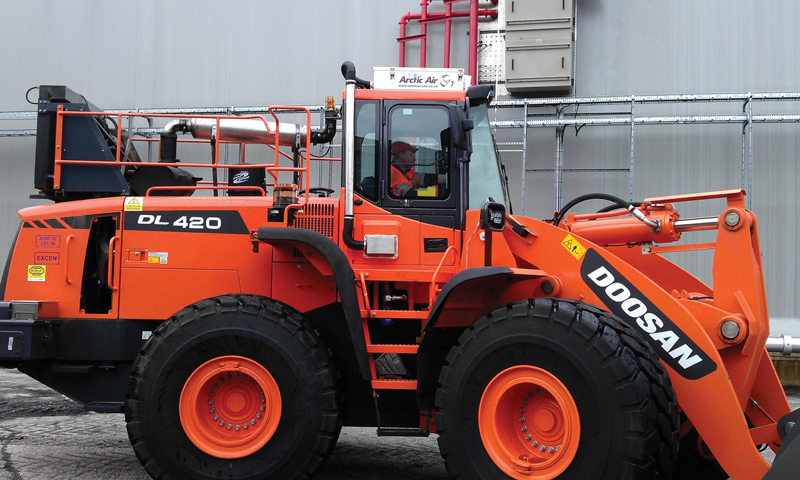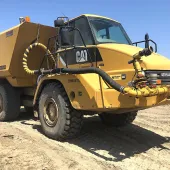Dust Control in Mobile Plant

First published in the December 2015 issue of Quarry Management as A Breath of Fresh Air
Julian Clark of Arctic Automotive Air Conditioning outlines the importance of dust control within the confines of the cab
Airborne dust can be found almost everywhere in the environment. The human respiratory system is designed to cope with acceptable levels of what are deemed as ‘non-harmful types of dust’. However, when plant and equipment are operated in the workplace, the amount of dust generated by normal work activities can be multiplied tenfold. Depending on the particular industry, dust can be classified from ‘moderately harmful’ to ‘deadly’ and must be filtered and dealt with in the correct way to avoid unnecessary illness or even death.
Dust can be further classified as breathable or respirable, depending on the size of the dust particles and the parts of the respiratory tract they are able to reach. Generally, when breathable dust is inhaled the body’s normal defence mechanisms are able to remove it by trapping it in saliva, nasal hairs and throat hairs (cilia), then ejecting it as phlegm. These mechanisms are only effective when the dust particles are larger than 10 microns.
Respirable dust particles are much smaller in size and, depending on the type of dust, often deadly. The body’s respiratory tract is unable to stop them from entering deep into the lung’s alveoli causing potentially permanent scarring to delicate lung tissue. This can result in relatively mild to life-threatening health issues in a very short period of time.
To help understand the different types of dust, a comparison of the safe work exposure limits (WELs) can be made (as documented by the Health and Safety Executive) between breathable dusts of 10mg per cubic metre of air breathed and respirable dusts of 4mg per cubic metre of air breathed.
However, the respirable crystalline silica (RCS) dust that can occur in the mining and quarrying industries is potentially so harmful to human health that it has an extremely low WEL of 0.1mg per cubic metre of air breathed.
The reason for this low WEL is partly due the size of the dust, but mainly because of the type of dust and its structure. RCS has a high quartz content and, although the body can cope with very small amounts of this, if left unchecked over a long period of time its effects are irreversible, leading to silicosis and permanent alteration or destruction of the lungs’ alveoli.
Silicosis classifications range from chronic (developing after 10 or more years of exposure) to accelerated (developing between five and 10 years) to the worst classification, acute (developing after less than five years of exposure), where the lungs become scarred, inflamed and fill with fluid, causing severe shortness of breath and low blood oxygen content.
Silicosis, asbestosis and coal miners’ black lung are among the most commonly known dust-related deadly diseases, but this does not have to be the case.
Dust control is governed by the Health and Safety Executive under The Control of Substances Hazardous to Health Act 2002 (COSHH). If adequate dust-control measures are implemented, the health and safety of employees working in hazardous dust environments can be improved to a safe level.
One such dust-control measure for operators of mobile plant in mining and quarrying environments, who can be at serious risk of succumbing to serious health issues if hazardous dusts and gases are allowed to enter the confines of the cab, is the installation of an air-filtration overpressure system to combat any dust ingress.
Contaminants can enter through many different routes, such as poor door and window seals, cable entry points and low-capacity ventilation filters with inadequate filter media. If the filter capacity is small it will block very quickly, restricting air flow and reducing the available oxygen content inside the cab, thereby increasing operator drowsiness; it will also allow contaminated air to bypass the filter and find alternative entry routes.
A correctly installed air-filtration overpressure system with multiple filter capacity is a key health and safety addition to the cab. Contaminated air outside the cab is drawn through a very high capacity pre-filter and then through a high-capacity HEPA filter capable of filtering contaminants down to 0.3 micron at 99.99% efficiency. The filtered air can also be drawn through a granulated activated carbon filter if additional protection is required against hazardous gases. The clean, oxygenated air is then pressurized within the cab to create a positive pressure inside and keep the contaminated air outside.
The cab’s internal pressure is regulated by the system’s cabin control unit (CCU) at a pre-set ‘safe’ overpressure for the operator. Any drop or increase in pressure inside the cab is sensed by the CCU which controls the overpressure system to maintain the pre-set pressure level. In addition to the regulated pressure control function, the CCU is equipped with a visual and audible alarm function should the internal pressure breech the pre-set minimum and maximum thresholds, along with an alarm and system cut-out function if the filters have been removed, thereby ensuring the operator cannot use the system without the filters being fitted. All system functions are fully automatic with no operator intervention required.
The installation of an air-filtration overpressure system is an effective solution to hazardous dust and gas control inside the operator’s cab. It provides a clean and safe working environment, thus demonstrating a high level of duty of care towards employees and preventing potential legal claims in the future.
For more information visit: www.arcticaircon.co.uk
- Subscribe to Quarry Management, the monthly journal for the mineral products industry, to read articles before they appear on Agg-Net.com








